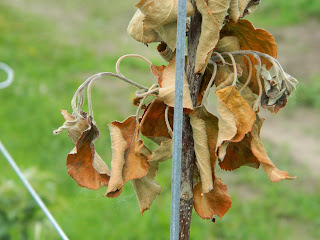 |
| A fall-bearing raspberry field. Photo: Annie Klodd |
Author: Annie Klodd, UMN Extension Educator - Fruit and Vegetable Production
In this week's update:
- Rotating cross arm trellis for blackberries
- Blueberries beginning to ripen - tentative U-Pick openings planned
- Plum curculio egg laying and feeding
- Aronia fruit yellowing
- Drought stress symptoms on fruit leaves
- Removing fire blight infections
Rotating cross arm trellis for blackberries
 |
| A rotating cross arm trellis system just installed near Afton, MN. Once the plants grow taller, high tensile wire will be installed along the trellis arms. Photo: Annie Klodd |
On Wednesday, I had to opportunity to check out a new rotating cross arm trellis that a Minnesota fruit grower recently installed in a brand new blackberry planting. The RCA trellis allows the canes to be grown at an angle, or almost horizontally, and then raised up for harvest.
This achieves two benefits: 1) easier harvest of berries, all hanging on one side of the trellis, and 2) allowing the primocanes to be lowered and covered over the winter to protect against cold temperatures, potentially making Minnesota blackberry possible. I am excited to see how this system works out, and will work with the grower to provide further updates.
This achieves two benefits: 1) easier harvest of berries, all hanging on one side of the trellis, and 2) allowing the primocanes to be lowered and covered over the winter to protect against cold temperatures, potentially making Minnesota blackberry possible. I am excited to see how this system works out, and will work with the grower to provide further updates.
Blueberries beginning to ripen - tentative U-Pick openings planned
Growers in the southern half of Minnesota are starting to report that their earliest berries are beginning to ripen. U-Pick farms are planning for a tentative opening the weekend of July 4th, or shortly thereafter and will have pre-picked fruit available in the days leading up.
Plum curculio egg lay and feeding injury
 |
| Plum curculio feeding damage on pear fruitlets. Photo: Cornell University. |
 |
| Plum curculio egg laying injury on a Harry Masters Jersey apple tree on 6/22/20. Photo: Annie Klodd. |
I have received numerous photos of damaged stone fruit and apples that is characteristic of plum curculio (PC) damage. Damage by PC is prevalent this year, likely due to the warm temperatures that we have been experiencing. Plum curculio feeding injury and egg laying injury look different, but both will cause the fruit to have unmarketable deformations as they grow around the injury point. Feeding injury looks like a small black dot or "pock mark," while egg-laying injury is a distinct crescent shape.
While the most critical time for controlling PC was the two weeks following petal fall, certain insecticides can still be applied now to reduce populations. This article from Michigan State University provides good detail on when and how to control PC throughout the season.
Aronia fruit yellowing and dropping
 |
| Aronia berries yellowing prior to ripening. Photo: Diane Bugeja. |
We continue to investigate an issue that I wrote about in last week's update, in which the fruitlets on aronia bushes are turning yellow and dropping from the plants. Shane Bugeja and I just had a phone call today with researchers at University of Connecticut, who have also been experiencing this issue for several years. The cause is currently unknown. It is likely a stress response to an environmental stress occurring between bloom and ripening, but further investigation is necessary to determine what stress is causing it, and how to prevent it.
Foliar nutrient tests and disease screening are currently being done on samples taken from one site in Minnesota, and we look forward to receiving the results; hopefully they shed some light on this issue.
Drought stress symptoms on fruit leaves
Before the rain events of earlier this week, much of the state has been experiencing below-average precipitation combined with high winds, high temperatures, and low humidity. This led to water shortage on fruit trees, shrubs and brambles, particularly in new plantings.
Drought stress can be exacerbated if lots of weeds are present, or if the trees are having to compete with dense grass around the trees. One way that some fruit species react to these conditions is with browning around the leaf margins.
 |
| Water stress on a 2-year old apple tree. Photo: Annie Klodd. |
Other symptoms of hot, dry weather early in the season may include slow growth on new plants, poor fruit set, small fruit size, and nutrient deficiency symptoms on the leaves such as leaf yellowing.
The photo above, showing a water-stressed apple tree, can be mistaken with potassium deficiency and frost damage.
Removing Fire Blight Infections
 |
| Both photos: Fire blight symptoms on newly planted dwarf apple tree saplings. Photo: Annie Klodd. |
I visited a new apple tree planting this week where a small number of the trees exhibited fire blight symptoms including the characteristic "shepherd's crook" and necrotic leaves on individual shoots. After letting me take photos for this article, the grower immediately sterilized his pruners with 10% bleach, pruned off the infected shoots below the infection, and sealed them in a garbage bag to be disposed of (see photo below).
 |
| Sterilizing pruning shears before and after removing fire blight-infected apple tree shoots. Photo: Annie Klodd |
If you're seeing interesting things in your fields, insects and diseases, or just want to share photos, we'd love to hear from you! As always, don't hesitate to reach out with questions and pictures. We're still here for technical assistance over the phone, via text, or via email.
Fruit questions go to Annie: kloddann@umn.edu
Vegetable questions go to Natalie: hoida016@umn.edu
Food safety questions go to Annalisa: hultb006@umn.edu
Fruit questions go to Annie: kloddann@umn.edu
Vegetable questions go to Natalie: hoida016@umn.edu
Food safety questions go to Annalisa: hultb006@umn.edu

Comments
Post a Comment